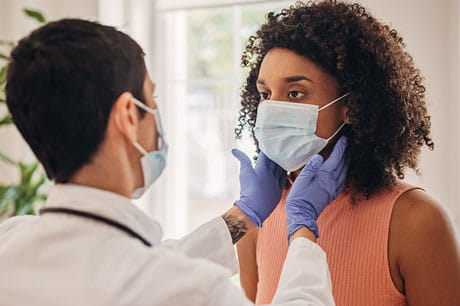Questions to ask before Mohs surgery
Get the answers you need to make the process as smooth as possible.
You were diagnosed with a skin cancer, and now your provider is recommending a procedure called Mohs surgery. Wondering what that involves? Asking the right questions can help you understand. If you’re not sure where to start, consider these.
What is Mohs surgery?
Mohs surgery is a precise technique used to treat certain types of skin cancer. The procedure is done in a doctor’s office or outpatient clinic under local anesthesia. The entire process is done in stages over the course of a few hours.
The surgeon will start by marking the location of your cancer. Then they’ll numb your skin with a local anesthetic and remove a layer of skin around the affected area, which goes to the lab for processing. The nursing team will bandage your wound, and you’ll wait while the sample is processed and analyzed in the lab.
“In the lab, the surgeon will ink the tissue sample and create a map, so if there are any cancer cells found, they can precisely remove them from the correct location,” says Mary Brady, MD, dermatologist at Geisinger.
A technician prepares slides of your cells, and the surgeon looks at them under a microscope to check for cancer cells. If any are still present, they’ll mark the location and remove more skin.
The surgeon will repeat the process until they can’t see any cancerous cells under the microscope. Once the skin cancer has been removed, your surgeon will talk with you about how to treat the wound. This may involve stitches, or you may be able to let the wound heal on its own.
Who is a candidate?
Mohs surgery may be right for you if your skin cancer is:
- In a sensitive area, like on your face, scalp, ears, neck or hands
- At risk of coming back
- Large or aggressive
If you’re a candidate for Mohs surgery, your provider will walk you through the process.
How do I prepare for Mohs surgery?
Before your procedure, your provider will review your medical history and medications. You may need to stop or adjust certain medications beforehand.
Because Mohs surgery can be a lengthy process, depending on the extent of your skin cancer, be prepared to spend a few hours at the office. When you’re getting dressed, opt for comfortable, loose-fitting clothes. Your provider will tell you if it’s OK to eat before your procedure.
To pass the time while you wait, consider bringing things to do, like a book, your phone or tablet and a snack (if allowed). And be sure to bring someone with you who can drive you home after the procedure.
What’s recovery like?
After the procedure, you may have some discomfort. Taking over-the-counter pain relievers can help. And you will need to wear the initial bandage for at least 24 hours. Your provider will give you instructions on when to remove it and how to care for your wound.
“Wound care is usually necessary for at least a week after the procedure, but some wounds can take weeks or even months to fully heal,” Dr. Brady says. Your provider will review all the ways to maximize healing after the procedure.
You may see your provider for a follow-up to evaluate how your wound is healing.
Will it leave a scar?
“The goal of Mohs surgery is to spare as much healthy tissue as possible,” says Dr. Brady. The size and type of scar depends on the location, size and depth of your initial skin cancer. Your surgeon will help you to get the best cosmetic outcome possible.
To reduce the appearance of scarring, Dr. Brady offers these suggestions:
- Stay out of direct sunlight and wear a hat and sun-protective clothing
- Wear SPF 30 or higher sunscreen daily
- Maintain a healthy diet and lifestyle
- Avoid smoking or nicotine products
- In some cases, scar products like silicone gel may be recommended
Laser resurfacing and microdermabrasion can also help lessen the appearance of your scar, if necessary. But most people don’t need additional scar treatments.
Does Mohs surgery cure skin cancer?
Because Mohs surgery is so precise, it’s very effective. “The cure rate for most new cases of skin cancer treated with Mohs surgery is 98% to 99%,” says Dr. Brady.
Talking it over
Once your provider determines if you’re a good candidate for Mohs surgery, the two of you will work together to talk about next steps. They’ll help you understand the procedure so you know what to expect. And they’ll be there to help put your mind at ease, so you can focus on getting back to the things you love.
Next steps:
Learn about cancer care at Geisinger
Mark on your lip? Here’s what it could mean
Meet Mary Brady, MD





